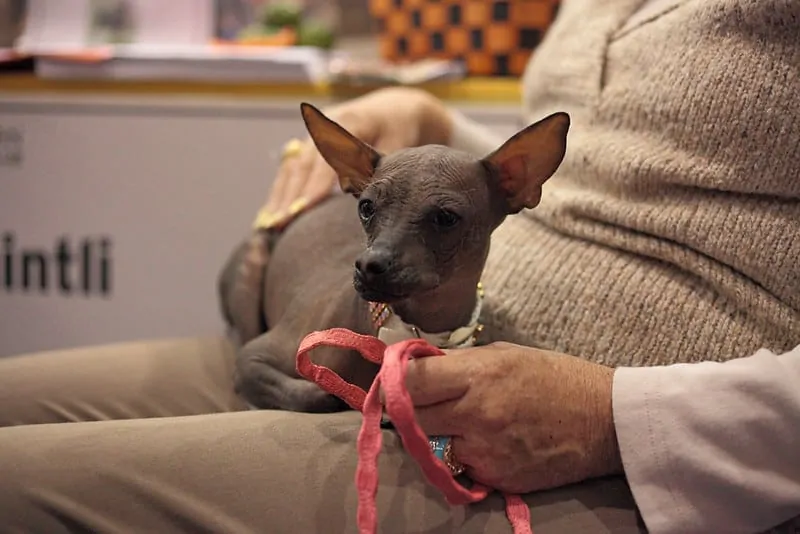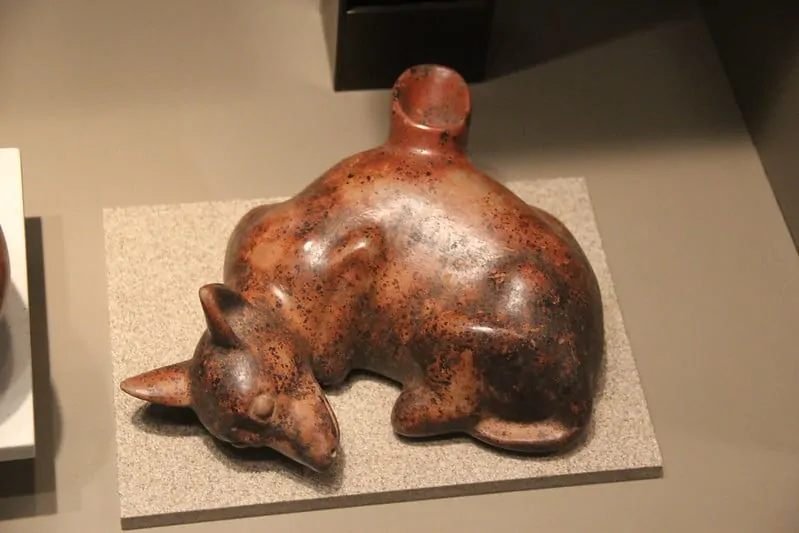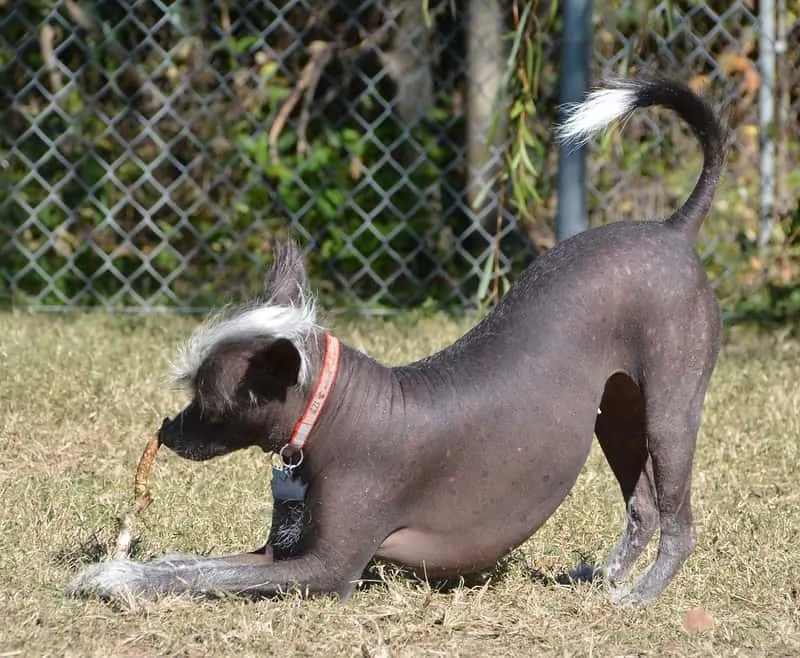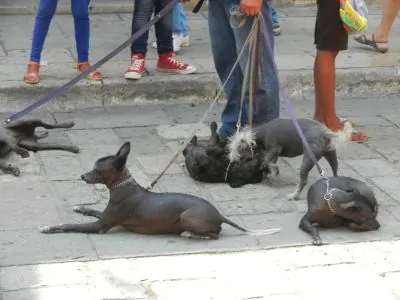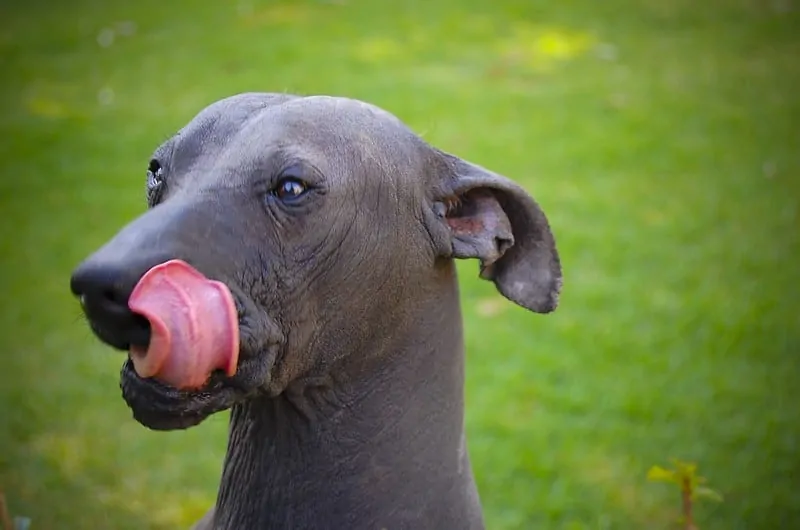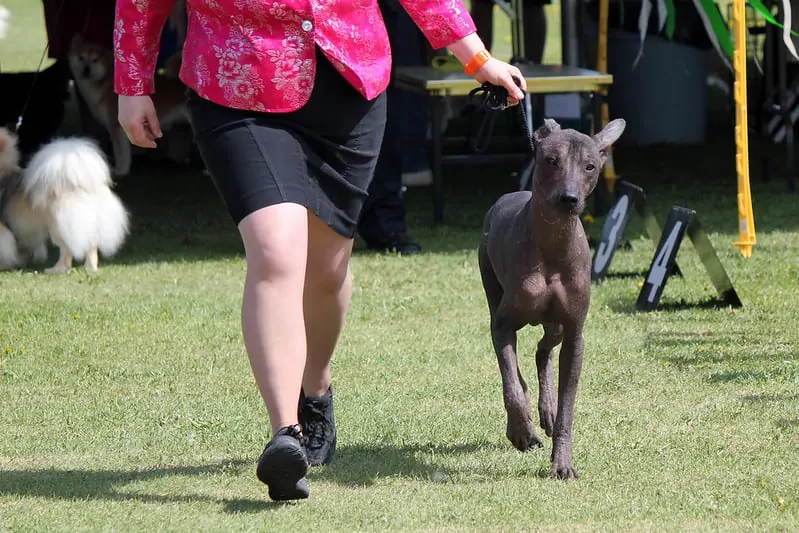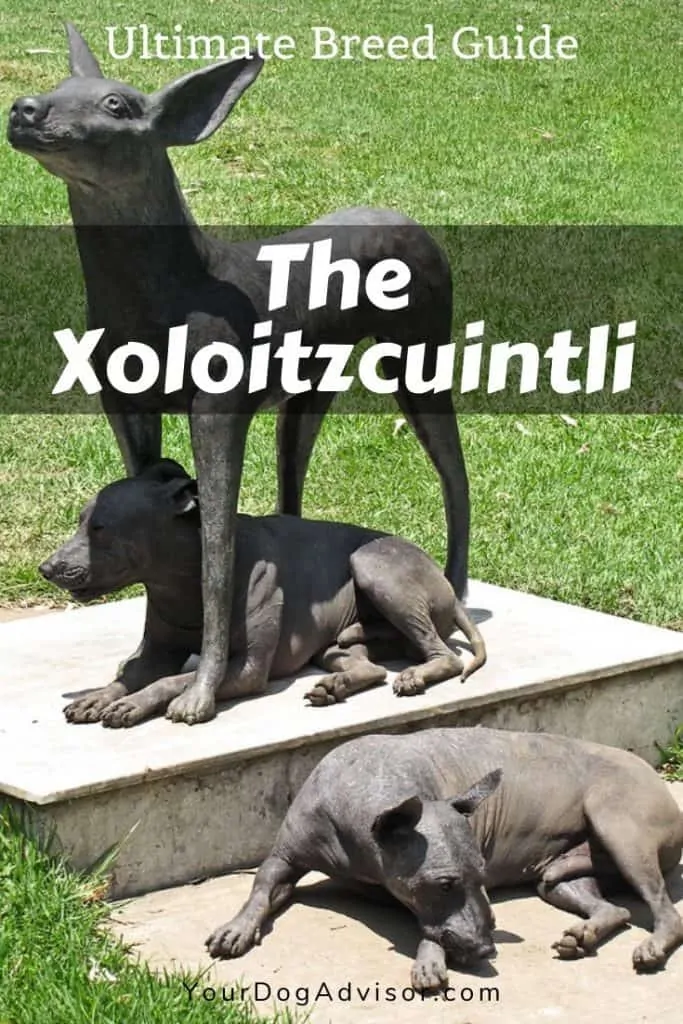As one of the rarest dog breeds in the world and by far the hardest breed name to pronounce, the Xoloitzcuintli (show-low-itz-queent-lee) or Mexican Hairless, is as unique a breed as you are likely to find. But don’t let this dog’s lack of popularity make you think they can’t be good pets. The truth is, for the right owner, this breed makes for an obscure but loyal companion.
Keep reading to find out why this rare “dog of the gods” really should be more popular than it is.
Contents
General Characteristics of the Xoloitzcuintli
- Other names: Mexican Hairless
- Height: Toy – 10 to 14 inches; Mini – 14 to 18 inches; Standard – 18 to 23 inches
- Weight: Toy – 10 to 15 pounds; Mini – 10 to 30 pounds; Standard – 30 to 55 pounds
- Lifespan: 13 to 18 years
- Origin: Ancient Mexico
- Colors: All colors and coats are seen with darker varieties being more common
- Activity level: High as puppies, low as adults
- Grooming needs: Minimal
- Best suited for: Attentive owners
The Xoloitzcuintli comes in three sizes, including the middle-sized “mini” shown above. These hairless wonders can be as small as a Chihuahua or as large as a Dalmatian. “2010 AKC Meet the Breeds” by Ccho / CC BY-NC-ND 2.0
The History of the Xoloitzcuintli
The Xolo is one of the oldest dog breeds still alive today. Their ancestors lived in what is present-day Mexico and survived the rise and fall of many ancient civilizations.
The first domesticated canines in the Americas followed humans over the land bridge between Alaska and Siberia over 9,000 years ago. The assumption is, that around 3,500 years ago, a spontaneous mutation occurred in one of the dogs living with the Olmec people of ancient Mexico. This dog was born without any hair.
As a rarity, the hairless descendants of this first bald dog were revered by ancient indigenous people. The Aztecs referred to it as the “dog of the gods” and believed these dogs were a gift from Xolotl, the God of the afterlife.
The dogs were considered sacred to many other ancient civilizations including the Toltecs and Mayan.
Many also believed the dogs held healing powers and would protect the home from evil spirits. This likely has some connection to the fact that these hairless dogs give off extra heat. They are still used in place of hot water bottles in many Mexican villages today. The breed is also notoriously good at guarding property.
Ancient statues and art depicting a hairless, prick-eared dog are common findings in the Mexican state of Colima, as are burial sites and tombs with Xolo skeletons. (https://www.flickr.com/photos/101561334@N08/9770818933/)
While these dogs are most famed for their lack of hair, it is important to note that each litter of Xoloitzcuintlis will contain both haired and hairless dogs. But it is only the hairless variety that was sacred to these ancient peoples and is the type most often depicted in statues and art.
In addition to being valued as a living pet, these dogs were often used as sacrifices to protect their owners in the afterlife. It is not uncommon to find hundreds of these dogs in ancient burial sites.
The Aztecs also raised these dogs for consumption. There are accounts from early Spanish settlers of Zolo’s being slaughtered for banquets and other special occasions including weddings and funerals.
The dogs were also used for hunting and protection.
Despite being around for thousands of years, the breed did not get official recognition as a breed in Mexico until 1950. The Xolo was recognized early on by the AKC starting in 1887 but was dropped from the official list in 1959 due to a lack of registered dogs.
To revive the breed, Mexican and British dog authorities set off into remote Mexico in 1954 to find healthy representatives of the breed in a widely publicized endeavor known as the Xolo Expedition. The expedition was eventually successful in reviving the breed, although the Xoloitzcuintli would not be re-recognized by the AKC until 2009.
The dog was named the official breed of Mexico in 1956.
Today, this breed’s numbers still remain quite low outside of Mexico and those that are lucky enough to own a Xolo often pay the price for that rarity in the form of constant questions and adorations from passersby.
<iframe width=”560″ height=”315″ src=”https://www.youtube.com/embed/0Vk5iKiOd8w” frameborder=”0″ allow=”accelerometer; autoplay; encrypted-media; gyroscope; picture-in-picture” allowfullscreen></iframe>
Learn more about this unique breed from one passionate breeder in the above video.
The Temperament of the Xoloitzcuintli
The Xoloitzcuintli is known to be a very perceptive dog and tends to be emotionally connected to their owners. This connection often translates into a very strong bond with their family.
They do tend to be more aloof with strangers but most are friendly after an introduction period. They are remarkable guard dogs and are known for being quiet except for when they detect an intruder, at which point they will bark quite loudly and excitedly to draw their owner’s attention.
As puppies, Xolos are very high energy and require a lot of attention and exercise. Adolescent dogs, especially, will benefit from a lot of mental stimulation as well as physical. Once they reach about two years of age, though, they tend to calm down and are known for being reserved and quiet, especially in the house.
An adult Xoloitzcuintli is usually content with one walk per day, but they do prefer more interactive playtime if they can get it. They enjoy cuddling with their humans but are also fairly independent overall.
This independence and a slight stubborn streak mean these dogs aren’t the best choice for a novice owner.
They are highly intelligent but take patience and ingenuity to train. Their history as a utility and hunting dog means they cannot always be trusted off-leash, though prey drive does tend to differ between individuals.
The Xolo is a playful dog with a laid back personality, though they are well known for being observant and make good watchdogs. Their observant nature extends to family and they are often referred to as the empaths of the doggy world for their keen ability to decipher human moods. “18_Bellaire _Dog_Park_Thanksging_2014” by Ron Kikuchi / CC BY-NC-ND 2.0
These dogs do come in three sizes, with different personality traits between them.
The toy variety tends to be the lowest energy type and generally enjoy snuggling up with their owners.
Both the mini and standard varieties tend to be typical of your normal working breed, though the larger dog is better suited for active outdoor adventures and dog sports.
This breed is not a great choice for cold climates, as even the haired variety have very short coats and are prone to shivering and shaking in cool weather.
Health Issues Common to the Xoloitzcuintli Breed
Having been subjected to natural selection for thousands of years, this breed tends to be very robust and is not prone to many health problems. There are a few issues to be aware of, however, especially if you choose a breeder that is less reputable than desired.
- Heart issues
- Eye issues
- Dental problems
- Hip dysplasia
- Luxating patella
- Acne
The gene that causes hairlessness in most of the individuals of this breed also affects the formation and development of teeth.
Almost all hairless individuals will also be missing teeth and may have some mandible malformation. While this generally does not cause any long-term problems, it does make teeth brushing all the more important.
While they may not look it, the Xoloitzcuintli is actually a very healthy breed. Aside from missing some teeth, even the hairless variety tends to be robust and long-lived. And, despite their exposed skin, their thick hide rarely experiences sunburns or injury. “Toy Xoloitzcuintli Puppy” by Lucas / CC BY 2.0
In a normal healthy mouth, the teeth will fit together perfectly when the mouth is closed. This rubbing between the top and bottom teeth aids in reducing plaque formation. If this process does not occur naturally, you will have to replicate it using a toothbrush or finger brush.
The haired variety of this breed does not experience these kinds of dental issues and only requires standard doggy brushing practices.
Interestingly, the gene that causes hairlessness in this breed is a dominant trait, meaning that the dog only needs to inherit one copy of the gene in order to be born without hair. It also means that if two haired Xolos are bred together, the entire litter will also have hair.
If a hairless Xoloitzcuintli is bred with a haired type (or any other breed of dog for that matter) about half the puppies will be hairless.
Sadly, if a puppy inherits the hairless gene from both parents, it is fatal and the pup will not develop. Breeding two hairless dogs together will result in a smaller litter but more of the puppies will be hairless than if you breed a hairless and haired pair.
Do Xoloitzcuintlis Do Well With Children and Other Pets?
In general, the Xolo is a very loving and loyal dog with family, including children. While it is in their nature to be gentle and affectionate with those they know, you will still need to put in some work to guarantee this.
All Xolo puppies will benefit greatly from socialization and exposure to many different people, animals, and experiences. If you have a child in the family or expect to build your family after you get your Xolo, it is important to expose them to babies, toddlers, and kids when they are very young puppies.
This ragtag gang of Xolos would have been a common sight on the ancient streets of the Aztec and Mayan Empires (minus the leashes). These dogs were often utilized to hunt in packs and many were likely running wild in the surrounding jungles prior to being taken in by humans. “Mexico_30” by Lester Gibson / CC BY-SA 2.0
Always do your best to ensure that any socialization with children is positive so that your dog will grow up seeing children as an enjoyable thing, not as something that should be feared or dreaded.
The same is true of Xolos and other dogs. In general, these pups tend to be very social animals with other canines. They lived for years in the jungles of Mexico hunting and running in packs with other Xoloitzcuintlis and ancient street dogs, and most tend to enjoy this same pack behavior today. But all will benefit from added socialization early on.
When it comes to smaller furry or feathery family members such as cats, rodents, and birds, most Xolos do well when introduced to these animals as puppies. There is some hunting instinct in the Xoloitzcuintli, but they don’t have as high a prey drive as your typical terrier or other hunting breeds.
What to Consider Before Bringing Home a Xoloitzcuintli
Think your home might be the perfect place for a Mexican Hairless (or haired) pooch? Here are a few more things to consider before committing to this unique breed.
While they may not look like your average pup, the Xolo has a heart as big as any other pooch and requires the full commitment and love of their owner. Before you bring home one of these hairless dogs, make sure you are ready for the responsibility. “Xoloitzcuintli” by Lucas / CC BY 2.0
Activity Level
When you buy a Xolo puppy, you are committing to two types of activity levels. When they are young, you will get a rambunctious, playful animal who will need a lot of activity. This active phase will last well into your Xolo’s adolescent years at which point they can easily become destructive if allowed to get bored. Both physical enrichment through walks, hikes, and outdoor play, and mental enrichment through training, dog sports, and stimulation toys, are important.
At around two years of age, most Xoloitzcuintlis tend to calm down considerably. While they still enjoy frequent walks and hikes and may even want to continue to engage in agility or trick training, adult Xolos are much more sedentary. They like to lay around the house and spend time soaking up the sun. Exercise is still important of course, but more so to keep them fit and healthy than to keep them from becoming destructive.
Trainability
Xolos tend to be very intelligent and willing to please, but their natural independence and stubborn nature make them a tough dog for novice owners to train. Most are highly food motivated and do well with positive reinforcement training. Because they are so in tune with their owner’s emotions, they do not do well with punishment training and tend to shut down whenever their owner becomes frustrated or upset.
Grooming
Grooming requirements for a hairless Xoloitzcuintli are about as minimal as grooming gets. All Xolos tend to be very clean animals and spend a lot of time grooming themselves. Unlike other hairless breeds, this dog is considered to have a hide rather than normal skin. As a puppy ages, this hide becomes thicker and darker and is very resistant to injury and sunburn. Natural oils in the skin facilitate this process, so frequent bathing can actually be detrimental. Some adolescent hairless Xolos will suffer from acne and may need some additional grooming care to help clear this up.
Haired Xoloitzcuintlis are also fairly easy to care for. They have a very short coat and don’t shed much. Like their hairless brothers, they are very clean and don’t require a lot of bathing. Both types do require frequent nail trims and dental care.
The haired variety of this dog, like the pup shown above, is almost unrecognizable compared to their hairless brothers and sisters. Aside from looks, dental deformities, and grooming needs, the haired and hairless Xoloitzcuintli are otherwise identical. “Untitled” by This Years Love / CC BY-NC-ND 2.0
Nutrition
Xoloitzcuintlis will do well on any quality commercial, raw, or homemade dog food suitable for a medium-sized breed, though toy varieties may require a small breed food fit for their higher metabolism. These dogs can be prone to weight gain so special care should be taken to portion out food correctly. As with all breeds, calorie intake should be matched to activity level and age.
Cost
It is possible to find a purebred Xoloitzcuintli for around $800, but for a quality hairless Xolo, expect to pay between $3,000 and $5,000.
Overall, though, this is a healthy breed with few extracurricular requirements and isn’t likely to cost more than your average dog to care for. However, they are longer lived than many breeds, so be sure you are committed to caring for your pup for the long haul.
10 Fun Facts About the Xoloitzcuintli
Now that you know what it takes to care for a Mexican Hairless, here are some fun facts about this highly unique breed.
- The name is taken from the Nahuatl word for dog, “itzcuintli,” and the God of the afterlife, Xolotl.
- Genetic studies have revealed that the Xoloitzcuintli is a true old-world dog and is more closely related to the domesticated dogs that crossed the Siberian land bridge than the ones that traveled with explorers.
- These same genetic studies confirmed that the Xolo and Chinese Crested, the most famous of hairless breeds, are not directly related.
- It is also suspected that the hairlessness gene in the Xoloitzcuintli is a different gene than the one that causes hairlessness in the Chinese Crested.
- There are close to ten true hairless dog breeds in the world with most originating in the Americas. In addition to the Chinese Crested, the Jonangi Dog from India and the Abyssinian Sand Terrier from Africa are some of the few hairless breeds from other parts of the world.
Despite being around for thousands of years, the Xolo didn’t even appear in dog show rings in its native Mexico until the late 1940s. It continues to be a rare sight in the dog show circuit to this day. “Xoloitzcuintli Mexican Hairless0579” by Marcia O’Connor / CC BY-NC 2.0
- Many reported sightings of the mythical chupacabra in Mexico end up being Xolo sightings.
- Most hairless Xolos have some hair on their heads and the tips of their tails, but the amount differs greatly between individuals.
- The haired variety looks very similar to the average street dog and comes in a wide variety of colors, making it hard to distinguish them from stray dogs in Mexico.
- A Xolo is featured in the Disney/Pixar movie Coco.
- The first Xolo didn’t compete in the Westminster Dog Show until 2012.
Before You Go
Not sure this dog of the gods is right for your household? Here are a few more breeds to consider.
“A Trio of Xoloitzcuintles” by Cristiano Oliveira / CC BY-NC 2.0

Sara Seitz has spent most of her life in the pet industry and has a bachelors in animal behavior from Colorado State University. Sara started working with dogs and cats as a high schooler at a rural boarding kennel. There she learned a lot about the bad and the ugly of the pet service industry. But not even the toughest day at that job would dissuade Sara from following her dream of working with animals.
In college, Sara got a job at a dog daycare and boarding facility in Fort Collins, Colorado. Her new career provided even more opportunities for learning about dog behavior than her classes did. As general manager of the daycare, Sara helped the company launch a new in-home pet sitting branch and trained to become a certified dog trainer. Between shifts taking care of peoples pets in-home and supervising dogs during playtime at the daycare, Sara organized and taught obedience classes.
Sara has always been passionate about bettering the lives of our canine companions. She soon found that advocating for and educating owners in the power of positive reinforcement training was one of the best ways to help dogs and their owners live happier lives.
